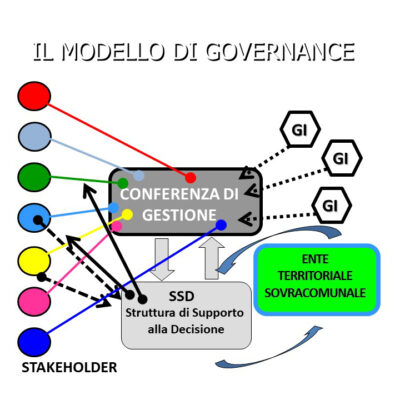The governance model and system management tools

The definition of a possible governance model for the Amalfi Coast was approached with a “systemic” approach, ie assuming the behavior of all the decision-makers who use the territory (or determine its use) not as a result, taken for granted or desired, of prescriptions of the plan, but as a characteristic of the system, to be taken into consideration in constructing the proposed solution to the various issues.
To correctly pose the problem of the governance model of a complex system such as the Amalfi Coast, it is not possible to ignore the “laws” that today govern the activity of political decision makers. Many of their choices are dictated more by the media coverage they may have than by their actual usefulness (or even by their conviction). Unpopular measures, but useful in the medium to long term, are postponed because they are too close to the electoral deadline. Or amazing interventions are announced, which the press reports with full-page titles (except to specify in some italics that, perhaps, there are difficulties in implementing them, implementation times are uncertain, resources are still to be found, etc.).
On the Amalfi Coast, these “systemic” difficulties are joined by a structural one: there is a lack of supra-municipal institutions capable of defining strategic objectives, translating them into a “plan”, monitoring their implementation. That is, the three conditions to allow the effective governance of the system are lacking.
The governance model proposed in the Amalfi Coast Management Plan provides for a political body, which defines the long-term objectives, and a technical-scientific structure that provides “knowledge” to the entire system of stakeholders and decision-makers, public and private, institutional and non-institutional. In this way, the PERMANENT INTEGRATED MANAGEMENT PROCESS desired by UNESCO and MiBACT can be activated.
In summary, the proposed governance model envisages:
• a Management Conference (CdG), the political body where all the local and superordinate actors are represented, who meet to define the vision of the community-territory system, the management mission;
• a “Decision Support Structure” (SSD), made up of technicians and experts from local administrations and from outside, which on the one hand elaborates studies and scenarios to support the CdG, on the other makes the information available to the system , the analyzes and the extended cost-benefit studies that allow the various stakeholders to know in advance the effects of the interventions in the project;
• a Supra-municipal Territorial Body (ETS) capable of supporting and coordinating the action of the various stakeholders, as well as implementing, directly or through an ad hoc public-private company, the actions and interventions envisaged in the Plan;
• The Interest Groups (IMs) freely constituted, even on a temporary basis – which play a proactive and possibly consultative role.
Read more on : Il modello di governance e gli strumenti di governo del sistema

